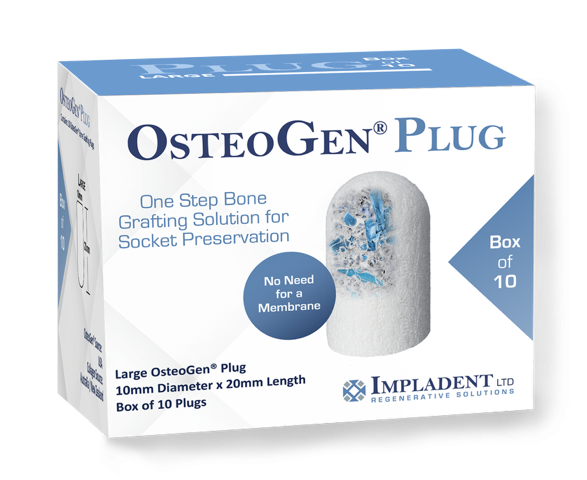Write your awesome label here.
Product Review:
Implant Ltd's OsteoGen® Plug

Innovative New Strategy
Makes Socket Preservation
Easy and Effective
The OsteoGen Plug by Impladent Ltd is allowing
all clinicians to consistently provide bone graft options.
[written by Ankur Gupta, DDS and Sam Shamardi, DMD ]
all clinicians to consistently provide bone graft options.
[written by Ankur Gupta, DDS and Sam Shamardi, DMD ]

Fifty years ago, when a patient needed a tooth pulled, the answer was simple. As dentists, we cared little about the contour and stability of the remaining bone. All that needed to be done, accounting for bleeding and infection, was to remove the tooth and happily move on.
This has changed dramatically in recent decades as dental implants have slowly but effectively become part of the collective consciousness of practitioners and their patients. Patients are often no longer carefree about what might happen to the socket and are increasingly uncomfortable with the idea of bone loss. Although they may not yet be ready for an implant replacement option, they do not want to lose bone and potentially complicate or even shut the door on that option in the future. Thus, it is incredibly important for all general dentists to be able to preserve the socket, no matter their level of surgical comfort or background education.
Under normal circumstances, the removal of a tooth and its stabilizing roots results in an empty socket. Normal healing quickly fills in the socket, but soft tissue always wins the race to replace the missing anatomy, resulting in bone loss in the edentulous area, bone loss to the adjacent teeth, and a collapse of buccal and lingual bone surrounding the socket. If a patient were to decide to place an implant in the future, these deviations in ideal bone contour often create either a surgical or restorative limitation for the dental implant.
Dentists have been aware of this phenomenon, but many general dentists choose not to preserve the socket because of a consistently agreed upon notion that socket preservation, and grafting in general, is complex, sophisticated, and should generally be relegated to well trained specialized surgeons. This creates a limitation in the standard of care, as patients often just want to have their tooth removed as soon and as simply as possible.
Under normal circumstances, the removal of a tooth and its stabilizing roots results in an empty socket. Normal healing quickly fills in the socket, but soft tissue always wins the race to replace the missing anatomy, resulting in bone loss in the edentulous area, bone loss to the adjacent teeth, and a collapse of buccal and lingual bone surrounding the socket. If a patient were to decide to place an implant in the future, these deviations in ideal bone contour often create either a surgical or restorative limitation for the dental implant.
Dentists have been aware of this phenomenon, but many general dentists choose not to preserve the socket because of a consistently agreed upon notion that socket preservation, and grafting in general, is complex, sophisticated, and should generally be relegated to well trained specialized surgeons. This creates a limitation in the standard of care, as patients often just want to have their tooth removed as soon and as simply as possible.
There are many reasons why general dentists choose not to employ socket preservation techniques as a part of their routine clinical repertoire...
... but probably the biggest reason is a lack of confidence in their clinical ability. Dental manufacturers have recently attempted to overcome this limitation by introducing bone grafting solutions that require very little surgical expertise. These solutions involve a tissue “plug,” in which a small, earplug-shaped malleable, cuttable bone graft can be packed into the socket immediately after extraction. This plug can be incorporated with traditional bone graft particles. It can be used in conjunction with a membrane and/ or soft tissue graft, but that is also optional. To add to the simplicity of this, the plug needs only to be sutured in place, with minimal need for primary closure.
These solutions involve a tissue “plug,” in which a small, earplug-shaped malleable, cuttable bone graft can be packed into the socket immediately after extraction. This plug can be incorporated with traditional bone graft particles. It can be used in conjunction with a membrane and/ or soft tissue graft, but that is also optional. To add to the simplicity of this, the plug needs only to be sutured in place, with minimal need for primary closure.
The OsteoGen Plug by Impladent Ltd is a combination of bone graft and collagen, including resorbable nonceramic bioactive calcium phosphate bone graft crystals and type 1 bovine Achilles tendon collagen. It attempts to combine the simplicity features shared with other plugs with the clinical effectiveness features found in traditional allograft and xenograft options.
These solutions involve a tissue “plug,” in which a small, earplug-shaped malleable, cuttable bone graft can be packed into the socket immediately after extraction. This plug can be incorporated with traditional bone graft particles. It can be used in conjunction with a membrane and/ or soft tissue graft, but that is also optional. To add to the simplicity of this, the plug needs only to be sutured in place, with minimal need for primary closure.
The OsteoGen Plug by Impladent Ltd is a combination of bone graft and collagen, including resorbable nonceramic bioactive calcium phosphate bone graft crystals and type 1 bovine Achilles tendon collagen. It attempts to combine the simplicity features shared with other plugs with the clinical effectiveness features found in traditional allograft and xenograft options.
Case Overview
Figure 1
Atraumatic extraction revealed chronic granuloma at the furcation of the 3 roots. Not only was there a lack of bone from the 3 roots, but there was also an obvious bony defect at the furcation, resulting from the granuloma.
Figure 2
Atraumatic extraction revealed chronic granuloma at the furcation of the 3 roots. Not only was there a lack of bone from the 3 roots, but there was also an obvious bony defect at the furcation, resulting from the granuloma.
Figure 3
The OsteoGen Plug provided an extremely convenient and efficient bone replacement option, where the plug was cut twice to mimic the 3 roots and packed into the sockets. A small platelet rich fibrin tissue plug was placed on top and secured with a figure 8 suture. Membrane placement is recommended but not required for this product.
Figure 4
Tooth post extraction. Note the intact walls within the socket; a membrane can still be used but is not necessary due to the integrity of the socket walls.
Figure 8
Flap adaptation with combination of
mattress and interrupted sutures.
mattress and interrupted sutures.
Figure 5
The OsteoGen Plug is placed into the socket. Light compression is needed to push down into the socket itself.
Figure 6
Plug visible within the socket.
Figure 7
Flap adaptation with combination of mattress and interrupted sutures.
Figure 9
Radiograph taken postprocedure,
after use of the OstenoGen Plug.
after use of the OstenoGen Plug.
The OsteoGen Plug was provided to 10 Catapult evaluators, including periodontists and general dentists, for review and analysis.
The procedural repertoire utilizing the plug was not limited to socket preservation immediately after extraction. Participants were asked to utilize it by immediately placing the plug into empty sockets after extraction. Participants were told that, following a thorough debridement, they simply needed to suture the plug into place without needing to employ any other complicated grafting procedures.
Several peer-reviewed studies have concluded with certainty that bone quality after 6 months of placing the OsteoGen Plug compares favorably with traditional grafting techniques.
When asked about the ease of use of the OsteoGen Plug, 9 of 10 Catapult evaluators found it to be easy or very easy. A similar percentage of evaluators chose not to place a membrane after packing the plug into place and found that not being required to place a membrane was “one of the great features of the product.” The second most favorable quality of the OsteoGen Plug was the ability to cut it to accommodate different-sized and bi- or trifurcated sockets.
After spending several weeks using the OsteoGen Plug and having the opportunity to experience its clinical features firsthand, 88.9% of Catapult evaluators intend to recommend the product to friends and colleagues, and 90% intend to continue using it in their own offices. Because a significant majority of Catapult evaluators found this product to be easy to use and intend to continue using the product after the evaluation period, Catapult would like to extend the Catapult Vote of Confidence to Impladent Ltd for their OsteoGen Plug.
Several peer-reviewed studies have concluded with certainty that bone quality after 6 months of placing the OsteoGen Plug compares favorably with traditional grafting techniques.
When asked about the ease of use of the OsteoGen Plug, 9 of 10 Catapult evaluators found it to be easy or very easy. A similar percentage of evaluators chose not to place a membrane after packing the plug into place and found that not being required to place a membrane was “one of the great features of the product.” The second most favorable quality of the OsteoGen Plug was the ability to cut it to accommodate different-sized and bi- or trifurcated sockets.
After spending several weeks using the OsteoGen Plug and having the opportunity to experience its clinical features firsthand, 88.9% of Catapult evaluators intend to recommend the product to friends and colleagues, and 90% intend to continue using it in their own offices. Because a significant majority of Catapult evaluators found this product to be easy to use and intend to continue using the product after the evaluation period, Catapult would like to extend the Catapult Vote of Confidence to Impladent Ltd for their OsteoGen Plug.
Ready to get started?
Enter your email for exciting offers from our partners, cutting-edge course offerings, and so much more.
Thank you!


